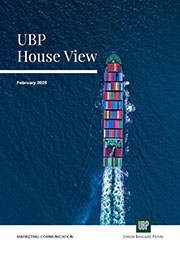On his return to the Oval Office, Donald Trump swiftly sparked uncertainty with a trade offensive against Mexico, Canada and China. We expect the return of protectionist policies to fuel market volatility in the months ahead. In this environment, hedge funds and precious metals stand out as resilient investment choices.
Key Takeaways
- Within the technology sector, we favour software, smartphones, and PC hardware.
- Investors should expand their equity holdings into financials, healthcare, and US mid-cap stocks.
- Hedge funds remain our preferred alternative to fixed income investments.
- Gold stays a strategic asset to hedge against the risks of resurgent inflation and higher interest rates.
Editorial
Trade policies fuel market volatility
The trade war has officially begun. Upon entering office, Donald Trump wasted no time in launching the first salvo of his trade offensive, creating uncertainties around Mexico, Canada and China. Europe will not be spared as the US administration targets sectors and countries with the largest trade surpluses.
Trump’s economic agenda makes explicit an economic war driven by strong decisions aimed at protecting traditional industries. In doing so, he is aligning his doctrine with that of China, which structurally supports economic activities deemed strategic. Once and for all, Trump has turned his back on free trade, considering competition to be unfair to American companies, particularly within their respective domestic markets.
The technology sector will be another battleground of this economic warfare, especially in relation to China, with artificial intelligence on the front lines. It is a long-term struggle for technological supremacy – one that Trump is determined to defend against at all costs.
As a consequence of his belligerent policies, volatility is on the rise and is expected to remain elevated in the months ahead. In this uncertain landscape, hedge funds and gold stand out as reliable havens, offering protection against market turbulence.
Strategy
Gold sparkles, but silver set to shine
After a post-Trump election slump in November 2024, gold rose nearly 6% in January, substantially outpacing both stocks and bonds as it breached USD 2,800/oz to close at another record high, not only in US dollar terms, but also in euro, yen, sterling, and Swiss franc terms.
In retrospect, we can see that this post-election pause represented yet another opportunity for investors to build positions in what we view as a core anchor to inflation-adjusted wealth preservation for multi-generational families.
Despite gold outperforming even the vaunted US equity markets – both the S&P 500 and the Nasdaq 100 – since the turn of the century, recent client meetings revealed two key sentiments: disappointment over not having larger gold exposures and concern that increasing positions at current levels may be unprofitable in the long run.
Though we empathise with the first, we disagree with the second concern. Looking back at the multi-year secular bull markets since US dollar convertibility to gold ended in 1971, all have delivered 4–6x returns. With the current secular bull market getting under way, as in 2015 when the European Central Bank began its quantitative easing programme and gold was near USD 1,000/oz, we believe that at USD 2,800/oz currently, gold continues to have significant scope for higher prices in 2025, with USD 3,000/oz also potentially in reach in the years ahead.
As was seen in the aftermath of the US presidential election, investors should expect periodic pullbacks in this admittedly volatile asset class. As was the case throughout 2023/24, we view these as opportunities to reinforce positions in the core anchor to inflation-adjusted wealth preservation in portfolios.
For those investors for who the apprehension about chasing a bull market in progress holds sway, there is fortunately a tactical alternative: silver. Currently, it takes just short of 90 troy ounces of silver to purchase a single ounce of gold. Over the past century, this has only happened on three occasions in light of transformational global economic events: in the late 1930s when World War II was beginning; in the early 1990s as the Cold War ended; and in 2020 amidst the global pandemic.
Undoubtedly, with the world order in the midst of another seminal shift, gold finds itself near historically expensive levels relative to its precious metal counterpart. Fortunately, investing in silver at or above this 90 ounces of silver / 1 ounce of gold threshold during the three historical episodes over the past century has allowed silver investors to outperform holding gold by an average of nearly 9% per annum over the following five years.
While gold remains the cornerstone of our precious metal allocation in portfolios for both investors who have not been able to build sufficient gold exposure in portfolios as well as existing gold investors seeking additional exposure, silver offers an opportunity relative to its yellow counterpart rarely seen over the past century.
Read our February House View for more insights.










